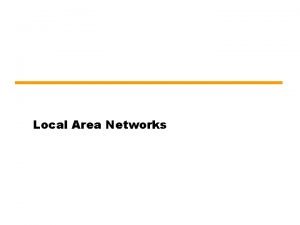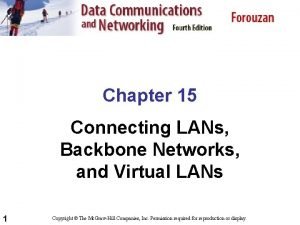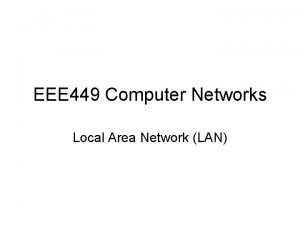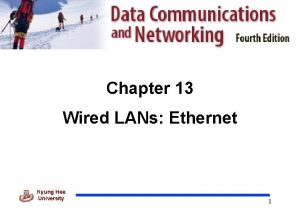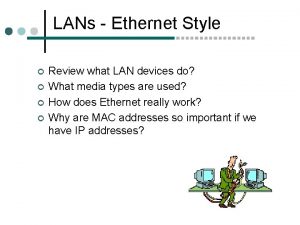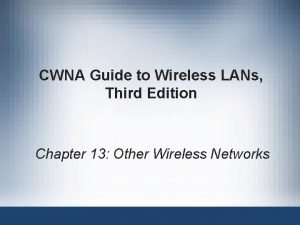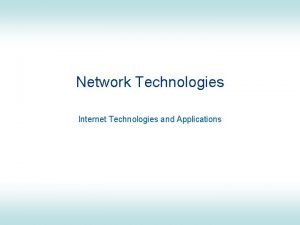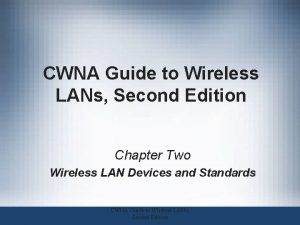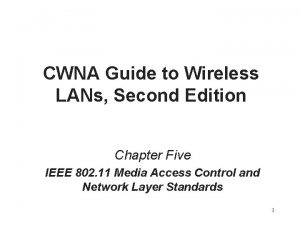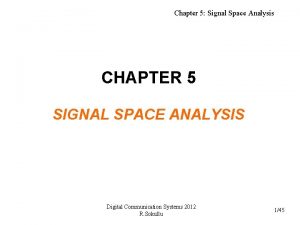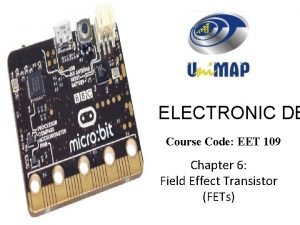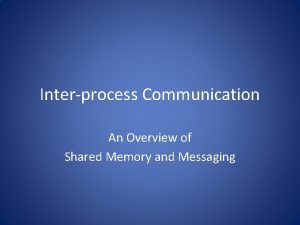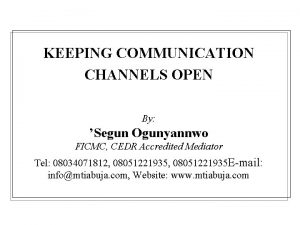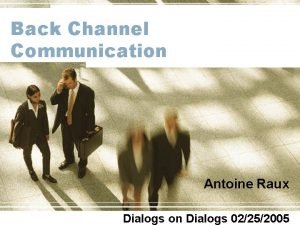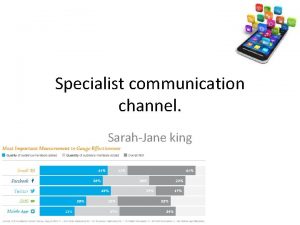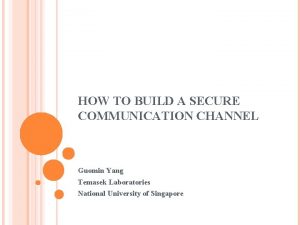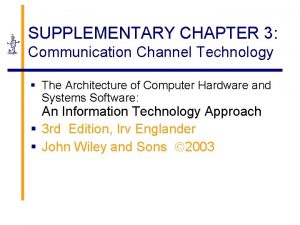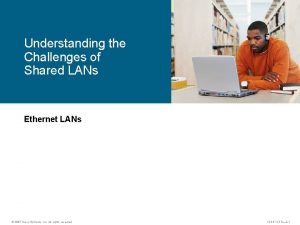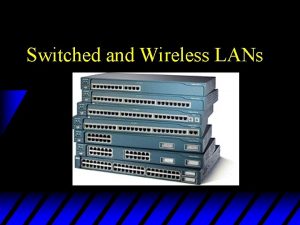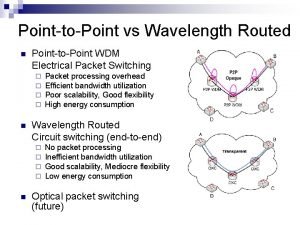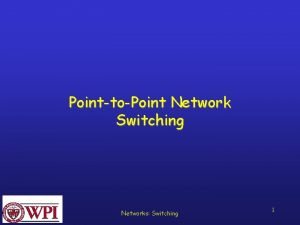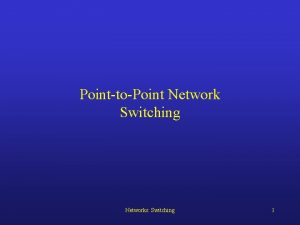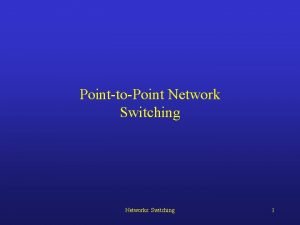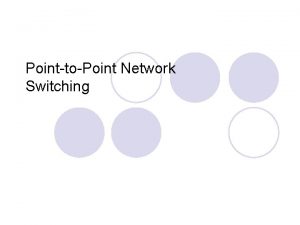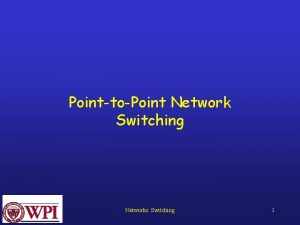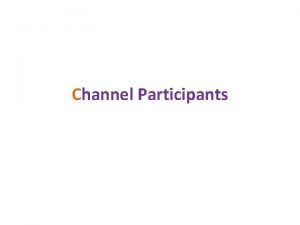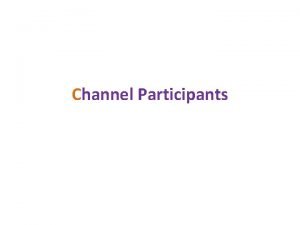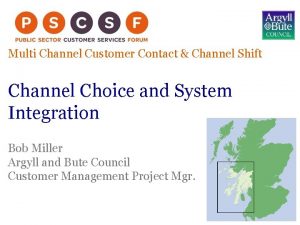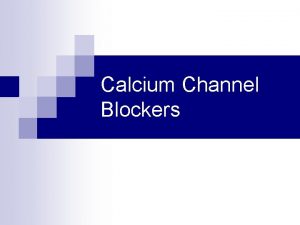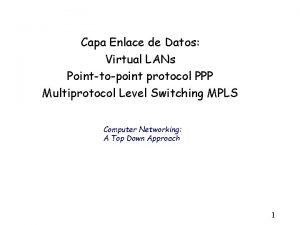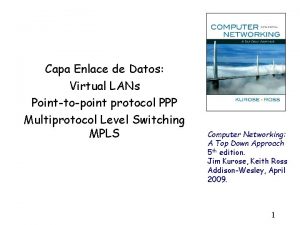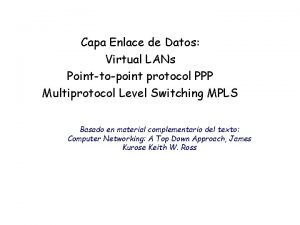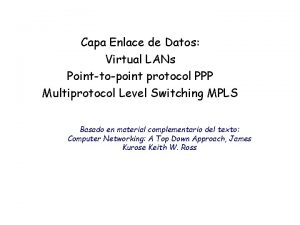PointtoPoint Vs Shared Channel Communication In LANs Pointtopoint






















- Slides: 22

Point-to-Point Vs. Shared Channel Communication In LANs • Point-to-point: – Computers connected by communication channels that each connect exactly two computers with access to full channel bandwidth. – Forms a mesh or point-to-point network. – Allows flexibility in communication hardware, packet formats, etc. – Provides security and privacy because communication channel is not shared. – Number of channels grows as square of number of computers for n computers: (n 2 -n)/2 • Shared or Broadcast Channel: – All computers connected to a shared broadcast-based communication channel and share the channel bandwidth. – Security issues as a result of broadcasting to all computers. – Cost effective due to reduced number of channels and interface hardware components. EECC 694 - Shaaban #1 lec #6 Spring 2000 3 -23 -2000

Ethernet • LANs developed in late 1960 s and early 1970 s. – Key idea: Reduce number of connections by sharing connections (communication channels) among computers. • Ethernet is the most widely used LAN technology: – Invented at Xerox PARC (Palo Alto Research Center) in 1970 s. • Defined in a standard by Xerox, Intel and Digital - DIX standard. • Standard is now managed by IEEE - defines formats, voltages, cable lengths, etc. , IEEE 802. 3: – 10 BASE-T: Standard Ethernet 10 Mbps. – 100 -BASE-T: Fast Ethernet 100 Mbps. – 1000 -BASE-T: Gigabit Ethernet 1000 Mbps. • One Ethernet cable is sometimes called a segment. – Limited to 500 meters in length for 10 BASE-T. • Uses: – Bus Topology: Single coax, cable forming a segment - the ether – Star Topology: Using hubs or switches (several segments). EECC 694 - Shaaban #2 lec #6 Spring 2000 3 -23 -2000

LAN Topologies Bus Requires fewer cables; may be disabled if cable is cut. Star or switch Easier to manage and more robust than bus connection, requires more cables Disabled if hub or switch is damaged. Ring Ease of synchronization; may be disabled if any cable is cut. EECC 694 - Shaaban #3 lec #6 Spring 2000 3 -23 -2000

LAN hardware: Network Interface Hardware EECC 694 - Shaaban #4 lec #6 Spring 2000 3 -23 -2000

LAN Interface Hardware • LAN interface hardware or Network Interface Card (NIC), handles all details of frame transmission and reception: – Adds hardware addresses, error detection codes, etc. to outgoing frames. – May use DMA to copy frame data directly from main memory. – Obeys access rules (e. g. , CSMA/CD) when transmitting. – Checks error detection codes on incoming frames. – May use DMA to copy data directly into main memory. – Checks destination address on incoming frames. • If destination address on incoming frame matches the local station's address, a copy of the frame is passed to the attached computer. • Frames not addressed to the local computer are ignored and don't affect the local computer in any way. EECC 694 - Shaaban #5 lec #6 Spring 2000 3 -23 -2000

IEEE Standard 802. 3 (Ethernet) • 1 -persistent CSMA/CD LAN. 10 -1000 Mbps. • Broadcast to several destinations possible using addresses with high-order bit = 1. • Random number of waiting slots upon a collision is chosen by binary exponential backoff algorithm: – First collision: wait 0 or 1 slots. – After i collisions wait a random number of slots between 0 and 2 i -1 with a maximum of 1023. – After 16 collisions, failure is reported to higher layers. • Simplified Channel efficiency = P /(P + 2 t/A) where: • A = kp(1 -p)k-1 k stations each with p probability to transmit in a contention slot. • P time to transmit a frame. • t worst case propagation delay. EECC 694 - Shaaban #6 lec #6 Spring 2000 3 -23 -2000

Coaxial Cable Bus Ethernet Connection Thick Coaxial Cable 10 BASE-5 Thin Coaxial Cable 10 BASE-2 EECC 694 - Shaaban #7 lec #6 Spring 2000 3 -23 -2000

Twisted-Pair Star Ethernet 10 -100 BASE-T Connection A hub or a switch forms the center of the star. or switch When a switch is used: • Every computer on the LAN is connected to its own Ethernet segment. No frame collisions: Frames directed by the switch to destination. • Every computer has access to full bandwidth (10 or 100 Mbps). EECC 694 - Shaaban #8 lec #6 Spring 2000 3 -23 -2000

IEEE STANDARD 802. 3 For LANS/MANS 802. 3 Frame Format 10 Base 5 10 Base 2 10 Base-T EECC 694 - Shaaban #9 lec #6 Spring 2000 3 -23 -2000

Collision Detection Delay in Ethernet, CSMA/CD As a result, the time to transmit a frame on the media must be longer than 2 t otherwise collisions will be undetectable to some stations. This determines the minimum allowed frame size. EECC 694 - Shaaban #10 lec #6 Spring 2000 3 -23 -2000

IEEE STANDARD 802. 3 10 BASE-T LANS/MANS Bit Encoding • Encoding ensures that the start, middle, end of each bit is known without using an external clock. • Aids in collision detection. • Requires twice the amount of bandwidth of straight binary encoding. • High signal =. 85 volts, low signal = -. 85 volts EECC 694 - Shaaban #11 lec #6 Spring 2000 3 -23 -2000

The 802. 3 (Ethernet) Frame Format • • Preamble: 7 bytes 1010 to synchronize station clocks. Start of frame byte: 10101011 Destination address. Source address. Length of data field. Data: 0 -1500 bytes. Pad: padding bits to make frame size more than the minimum size (~64 bits) Checksum: 4 bytes (CRC-32). Minimum frame size: The time to transmit a frame on the media must be longer than 2 t otherwise collisions will be undetectable to some stations. CRC-32 EECC 694 - Shaaban #12 lec #6 Spring 2000 3 -23 -2000

Efficiency of 802. 3 Ethernet at 10 Mbps With 512 Bit Contention Slot Time EECC 694 - Shaaban #13 lec #6 Spring 2000 3 -23 -2000

Gigabit Ethernet, IEEE 802. 3 z · · · Standard not fully specified, to be completed in 2000. Allows half- and full-duplex operation at speeds of 1000 Mbps. Uses the 802. 3 Ethernet frame format. Uses the CSMA/CD access method. Addresses backward compatibility with 10 BASE-T and 100 BASE-T technologies · Proposed channel types: · 1000 BASE-SX: Multimode fiber-optic link, maximum length of 550 meters. · 1000 BASE-LX: Single-mode fiber-optic link, maximum length of 3 kilometers. · 1000 BASE-CX: Copper-based twisted-pair link with a maximum length of at least 25 meters (to be extended to 100 meters). EECC 694 - Shaaban #14 lec #6 Spring 2000 3 -23 -2000

An Ethernet-Based LAN Architecture Example High bandwidth requirements 1000 BASE-T Highest cost per port and lowest of ports /Hubs Medium bandwidth requirements 100 BASE-T Low bandwidth requirements 10 BASE-T Lowest cost per port, largest number of ports EECC 694 - Shaaban #15 lec #6 Spring 2000 3 -23 -2000

IEEE Standard 802. 4: Token Bus • A linear or tree-shaped bus with N stations. • Stations are organized as a logical ring where each station knows the address of its logical right and left neighbors. • Only the station in possession of a special control packet “token” is allowed to transmit. • Once a station is done transmitting it passes the token to one of its two logical neighbors. • A station in possession of the token and data to transmit passes it on. • Collision-free protocol; no starvation. EECC 694 - Shaaban #16 lec #6 Spring 2000 3 -23 -2000

IEEE Standard 802. 5: Token Ring • N stations connected using point-to-point links to form a ring. • A 3 byte token circulates around the ring • A station desiring to transmit removes the token from the ring and once it passes by and converts a single bit in the token to 1 indicating the start of a frame. Listen Mode Transmit Mode EECC 694 - Shaaban #17 lec #6 Spring 2000 3 -23 -2000

IEEE 802 Frame Formats IEEE 802. 3 Ethernet IEEE 802. 4 Token Bus IEEE 802. 5 Token Ring EECC 694 - Shaaban #18 lec #6 Spring 2000 3 -23 -2000

Fiber Distributed Data Interconnect (FDDI) • • FDDI is another ring LAN technology. Transmits data at 100 Mbps. Uses pairs of fiber optic cables to form two counter-rotating concentric rings in which data flows in opposite directions. In case of fiber or station failure, remaining stations loop back and reroute data through spare ring. All stations automatically configure loop back by monitoring data ring. EECC 694 - Shaaban #19 lec #6 Spring 2000 3 -23 -2000

Asynchronous Transfer Mode (ATM) Star Network • ATM technology consists of ATM cell switches to which computers are connected using fiber optics in a star topology. • Computers get point-to-point connections - data from transmitter is routed directly through the ATM switch to destination at a data rate 155 Mbps or 622 Mbps. A single ATM cell EECC 694 - Shaaban #20 lec #6 Spring 2000 3 -23 -2000

ATM-Based LANs ATM Switch ATM LAN emulation EECC 694 - Shaaban #21 lec #6 Spring 2000 3 -23 -2000

Bridges Devices used to connect multiple LANs with different protocols or segments of a single LAN. Bridge Cluster on a single LAN Bridge CSMA/CD LAN Token bus LAN EECC 694 - Shaaban #22 lec #6 Spring 2000 3 -23 -2000
 High speed lans
High speed lans Connecting remote lans
Connecting remote lans Lans
Lans Ethernet evolution through four generations
Ethernet evolution through four generations Lans style
Lans style Cwna guide to wireless lans 3rd edition
Cwna guide to wireless lans 3rd edition Internet technologies and applications
Internet technologies and applications Show that the maximum efficiency of pure aloha is 1/(2e)
Show that the maximum efficiency of pure aloha is 1/(2e) Adam lans
Adam lans Cwna guide to wireless lans
Cwna guide to wireless lans Cwna guide to wireless lans
Cwna guide to wireless lans Unicast
Unicast Multi channel retailing advantages and disadvantages
Multi channel retailing advantages and disadvantages Signal space analysis in digital communication
Signal space analysis in digital communication Jfet self bias configuration
Jfet self bias configuration Shared memory linux
Shared memory linux Ficmc meaning
Ficmc meaning Back channel communication
Back channel communication Specialist communication channel
Specialist communication channel Secure communication channel
Secure communication channel Supplementary channel of communication
Supplementary channel of communication Communication channel threats
Communication channel threats Shared inquiry definition
Shared inquiry definition
